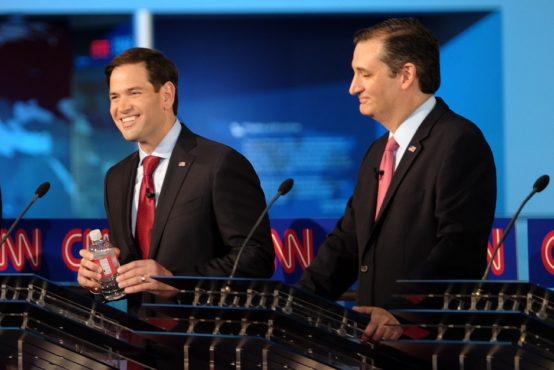Fake news correspondent Al Madrigal, of The Daily Show, recently pondered if presidential candidates Senators Marco Rubio (R-FL) and Ted Cruz (R-TX) were really Latinos. While discussing immigration, Jon Stewart began the exchange by asking Al Madrigal if he was excited about the first two serious Hispanic candidates, Cruz and Rubio. The conversation went as follows:
Madrigal: I guess those guys are technically Latinos. I mean there’s a lot more to ‘being Latino’ than being Latino.
Stewart: Because they’re weak on immigration?
Madrigal: Well, maybe – but mainly because they’re Cuban; a small and – I gotta be honest – snooty subset; they’re like the WASPs of the Latino world. You can’t expect the bulk of us non-Cuban Latinos to go crazy for two Cuban guys who threw away a path to citizenship for a path to the White House
De La Torre (sitting at home watching): ¡Ouch!
As a Cuban born Latino, I am cognizant that those of us from the island have a different historical habitus than other Hispanics who came to these shores (or had the borders cross over them). This first wave (1959-1962) of Cubans, considered “political exiles,” numbered 215,000. Demographically, they were quite homogeneous, as the vast majority were comprised mostly of whites (94 percent), who were middle-aged (about thirty-eight years old), educated (about fourteen years of schooling), urban (principally La Habana) and literate in English.
The second wave (1962-1973) brought 414,000 refugees who were also predominately white, educated, middle class and willing to work below minimum wages. While in Cuba, they largely constituted the group directly relying on economic links with the United States. On average they were semi-skilled working-class people who capitalized on the emerging economic enclave being established by the first wave Cubans. While all strata of Cuban society were represented in these first two waves, it was obvious that the vast majority of Cubans, unlike the two largest Hispanics groups – Mexicans and Puerto Ricans – consisted of those from the upper echelons and the middle class who most benefitted from the pre-Castro regime.
The Hispanic ethnicity construct attempted to imitate Eurocentric culture.
The Hispanic ethnicity construct by these first two waves attempted to imitate the dominant Eurocentric culture, the same culture whose neocolonialist ventures in our homeland during the first half of the twentieth century caused us to be refugees. Emasculated by the United States’ neo-imperialism, these two first waves now looked toward their oppressor to define themselves. Paulo Freire’s concept of “submerged consciousness” helps explain why the first two waves of Cubans desired at all cost to resemble their oppressor, yearning for equality with the “eminent” men of the United States. A genealogy was constructed that portrayed Cubans as white people coming from a white nation, fleeing tyranny with only the clothes on their backs – ignoring Cuba’s African and Chinese roots.
Pierre Bourdieu’s concept of habitus is also helpful in illuminating how these first two waves of Cubans eventually ascended the socioeconomic institutions of Miami. Being born into positions of privilege in Cuba, they had a socially constructed lifestyle that facilitated their rise to the echelons of Miami’s power structures. These social constructs, manifested as customs, language, traditions, values, etc. existed prior to their birth; social constructs that were whiter, with more formal education, and more urban than migrants from other Latin American countries. From the moment of birth, these constructs were imposed on them, molding their childhood, and guiding them through adulthood. Cubans are not superior to other Hispanic groups (although some white Cuban racists might disagree); they merely had to assert what they were in order to become what they are, an effort done with the unselfconsciousness that marks their so-called “nature.”
The idea of Cubans as whites coming from a white nation was something challenged by the 1980 Mariel boatlift. Unlike the elite first wave, or the middle class second wave, these Cubans resembled the population’s masses. Forty percent of these refugees were biracial. Not surprisingly, an immediate distancing commenced between the established Miami Cuban community and these new arrivals due to racism and classism. These newest arrivals came to be pejoratively known as Marielitos, differentiating this group of Cubans from all previous Cubans. Marielitos occupied their own constructed space, defined by both racist Cubans and racist Anglos as hardened criminals, homosexuals and scum.
In spite of these latest biracial Cubans, the construct of the earlier two waves persisted. As much as it may hurt to admit, Al Madrigal may be right in asserting that Cubans are the WASPs of the Latina/o world. If true, those who arrive at some simplistic conclusion that Rubio and Cruz are the Republican answer to their Hispanic dilemma will be sorely disappointed when the rest of the non-Cuban Latina/os fail to support them, regardless of their claim of sharing their ethnicity, and instead vote for the candidate willing to share their struggles. Being born to Hispanic parents (or marrying a Hispanic, i.e. Jeb Bush) a Latino does not make.
Cubans have struggled to be accepted among Hispanics.
Due to this Cuban-American habitus, Cubans have struggled to be accepted among Hispanics. Those of us who work toward Latino/a social justice are at times viewed with suspicion by our fellow Hispanics, having to first prove, through our praxis, our commitment to the Latina/o plight. Unfortunately, some of my Cuban compatriots attempt to mask these differences by advocating some essentialized pan-Hispanicness.
The dominant Eurocentric culture is thus not alone in attempting to construct Latino/as as monolithic. During the early development of Hispanic theological thought in the 80s and 90s when many of the original architects of the discourse were of Cuban descent, an emphasis was placed in constructing a pan-Hispanic identity. Many of these early Cuban religious scholars engaged in a strategy not duplicated by other academic disciplines, by either writing on pan-Hispanic themes or appropriating the religious symbols of other Latina/o ethic groups.
Most scholars today recognize the importance of differences; nevertheless, essentializing terms like “latinamente” as in “doing theology latinamente” continue to be used. Such pan-Hispanic terms become more of an academic construct than anything existing within the grassroots of Hispanic thought. When a Pew research study asked Latino/as whether they share a common culture, only 29 percent said yes. A full 69 percent confirmed that Latina/os in the U.S. have many different cultures. By a margin of more than two-to-one across nearly all major demographic Hispanic subgroups, more said that Latino/as have many different cultures instead of sharing a common one.
The danger of insisting on one Hispanic religious trajectory is that those who get to define what latinamente is, submerge if not silence other religious perspectives that may not be the norm, but are no less crucial to the identity of some Hispanics. If indeed all religious reflections are contextual, then it becomes impossible to have one Latino/a theological or religious perspective. Many do exist. Cubans are indeed different from other Hispanic groups. There are commonalities, but they are less unifying, as terms like latinamente would suggest. The task before us is to recognize commonalities without preferring them over and against differences.
So, can a Cuban be a Latino/a? Is there any hope for Rubio or Cruz to be Latinos? Is there any hope for me? Such questions get at the heart of any attempt to determine what is, and what is not Hispanic, and, more importantly, who gets to call themselves a Latina/o. If a matrix of voices exists within diverse Latina/o communities, which ones rise to the top? Which perspectives are created in the halls of power are then imposed upon Hispanic communities? Which identities arise from the grassroots?
A Cuban can choose to be a Latina/o if s/he makes a preferential option for Hispanics who are marginalized by the overall Eurocentric social structures.
A Cuban can choose to be a Latina/o if s/he makes a preferential option for Hispanics who are marginalized by the overall Eurocentric social structures. This occurs when Cubans crucify any race and economic privilege they may have (or just claim to have) and make a conscious choice to stand in solidarity with the vast majority of Hispanics who are disenfranchised and dispossessed. For Cubans to be Latina/os, they must move away from aligning themselves with those who benefit from the way society is constructed, hoping to capitalize on the tokenism of organizations seeking brown faces with white voices. Yes, there is more to “being Latino” then being Latino. For us Cubans, we cannot claim to be Hispanic while supporting policies and legislations that continue to harm the Latina/o community. If a Hispanic tree is known by its fruit, then what fruit has been produced by the trees of Rubio and Cruz? I must ask myself this same question. Whatever identity we name and claim remains irrelevant. It is what we are doing among, and in solidarity with, the Hispanic community that ultimately defines whether a Cuban can or cannot be a Latino or Latina.
Featured Image: Senators Marco Rubio and Ted Cruz standing side by side. Edited screen shot of GOP Presidential Primary Debate at the Reagan Library in Simi Valley, CA, on September 17th, 2015.


